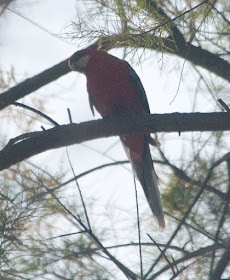Golden Jackals (Canis aureus) are surely the highlight for foreign nature-lovers visiting the park, but apparently they are not beloved by the Israelis themselves. They have become extremely abundant in the country, and have been subjected to government culling programs in consequence. The jackals in HaYarkon Park are apparently recent arrivals, but they are doing well. Short of putting out baits laced with rabies vaccine, the authorities seem to be leaving them to their own devices.
Our early morning visit found the jackals still active. Members of the pack (there are apparently two established packs in the park) played games of chase along the water's edge...
The birders, of course, were more interested in birds. The gentleman in shorts in the lower photograph, by the way, is Øystein Størkersen of Norway, former chair of the CITES Standing Committee and a devoted birder.
The birds were there in quite satisfactory numbers, including common species such as this White-spectacled Bulbul (Pycnonotus xanthopygos).
Some of the commonest birds in the park, are, however, exotics. Monk Parakeets (Myiopsitta monachus), natives of temperate South America, fill the crowns of trees with their enormous communal nests (they are called Monk Parakeets because of the supposed resemblance of a communal colony to a crowded monastery). They do the same in parts of Europe and North America. In Israel, where the climate may be ideal and there is a lot of fruit farming, their population has grown exponentially, at a faster rate than in other countries.
Other parrots in the park may simply be escapees. This appear to be a hybrid between two species of Australian rosella (Platycercus), presumably the white-cheeked Eastern (P. eximius) and the largely red Crimson (P. elegans). Needless to say, hybridizing these birds is not a good idea!
Egyptian Geese (Alopochen aegyptiacus) bred in Israel up to the 1930s, but these birds probably represent (like the parrots) escapees from aviculture.
As on my last visit, birds like this Little Egret (Egretta garzetta) were common along the Yarkon River and around the park’s ponds.
The amount of waterside habitat makes HaYarkon a good place to find kingfishers. We found all three of Israel’s resident species, and seeing them together provided a good illustration of Israel’s position at the epicentre of three continental faunas. The White-breasted Kingfisher (Halcyon smyrnensis), the common kingfisher of West Malaysia and Singapore, is here at the other edge of its range, which extends across Asia from Turkey to the Philippines.
The Pied Kingfisher (Ceryle rudis), on the other hand, is a common African species, ranging throughout the continent south of the Sahara and along the Nile Valley to Egypt. It apparently colonized Asia from Africa, and is common from India to China, but it does not reach Malaysia.
Finally, the Common Kingfisher (Alcedo atthis) is the kingfisher of Britain and Europe (and the species to which the name “kingfisher” was first applied). Like the others, it has a broad range - in fact, the broadest of all, not only extending throughout Asia but south and east as far as New Guinea and the Solomon Islands.
In short, HaYarkon Park is a good place to start for any naturalist visiting Israel - and, as this photo shows, it is also a good place to be a balloonist. That, however, is something I have no desire to try!
The amount of waterside habitat makes HaYarkon a good place to find kingfishers. We found all three of Israel’s resident species, and seeing them together provided a good illustration of Israel’s position at the epicentre of three continental faunas. The White-breasted Kingfisher (Halcyon smyrnensis), the common kingfisher of West Malaysia and Singapore, is here at the other edge of its range, which extends across Asia from Turkey to the Philippines.
The Pied Kingfisher (Ceryle rudis), on the other hand, is a common African species, ranging throughout the continent south of the Sahara and along the Nile Valley to Egypt. It apparently colonized Asia from Africa, and is common from India to China, but it does not reach Malaysia.
Finally, the Common Kingfisher (Alcedo atthis) is the kingfisher of Britain and Europe (and the species to which the name “kingfisher” was first applied). Like the others, it has a broad range - in fact, the broadest of all, not only extending throughout Asia but south and east as far as New Guinea and the Solomon Islands.
In short, HaYarkon Park is a good place to start for any naturalist visiting Israel - and, as this photo shows, it is also a good place to be a balloonist. That, however, is something I have no desire to try!






















No comments:
Post a Comment